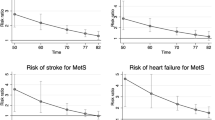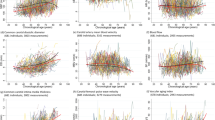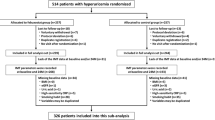Abstract
Different methods can be used to define healthy vascular ageing (HVA). In this prospective cohort study, we explored three different definitions in order to provide guidance for which to use. 2718 subjects were included from the Cardiovascular (CV) arm of the Malmö Diet Cancer Study (MDCS; median age 71.9 years, 62.2% females). Three different definitions of HVA were used: HVA-1 (<15th percentile of aortic pulse wave velocity (aPWV) distribution from age-quintiles); HVA-2 (<35th percentile of aPWV+ <35th percentile of carotid Intima-Media Thickness. cIMT); and HVA-3 (aPWV < 7.6 m/s + no hypertension). The HVA-1 and HVA-2 groups were compared with the HVA-3, and to the corresponding groups without HVA (non-HVA), in cross-sectional analyses for baseline characteristics and using Cox regressions for prospective risk, yielding hazard ratios (HRs) adjusted for conventional risk factors. A composite CVD endpoint was used, consisting of myocardial infarctions, ischemic heart disease mortality, and coronary artery procedures. The baseline characteristics were, with minor exceptions, similar across HVA groups. In the fully adjusted model, the HRs (95%CI) were 0.62 (0.41–0.93), 0.45 (0.26–0.76), and 0.56 (0.34–0.91) for HVA-1, HVA-2, and HVA-3, respectively. In summary, this observational study of elderly subjects provides examples of integrating hypertension and cIMT in the definition of HVA, as compared with only using aPWV. As aPWV itself is such a robust marker of HVA, it is demanding to find additional markers which improve the definition. There is a need to create a generally accepted definition of HVA.
This is a preview of subscription content, access via your institution
Access options
Subscribe to this journal
Receive 12 digital issues and online access to articles
$119.00 per year
only $9.92 per issue
Buy this article
- Purchase on Springer Link
- Instant access to full article PDF
Prices may be subject to local taxes which are calculated during checkout



Similar content being viewed by others
Code availability
The statistical analyses were done using “R: A language and environment for statistical computing”, version 3.4.2 for Windows 64 bit. The package “Regression Modeling Strategies”, version 5.1-2 (https://CRAN.R-project.org/package=rms) was used for the regressions. The code used for the analyses can be accessed by contacting the author Benjamin Nilsson Wadström at: benjamin.wadstrom@gmail.com.
References
Groenewegen KA, den Ruijter HM, Pasterkamp G, Polak JF, Bots ML, Peters SA. Vascular age to determine cardiovascular disease risk: a systematic review of its concepts, definitions, and clinical applications. Eur J Prev Cardiol. 2016;23:264–74.
Terentes-Printzios D, Vlachopoulos C, Xaplanteris P, Ioakeimidis N, Aznaouridis K, Baou K, et al. Cardiovascular risk factors accelerate progression of vascular aging in the general population: results from the CRAVE study (Cardiovascular Risk Factors Affecting Vascular Age). Hypertension. 2017;70:1057–64.
Fine I, Kuznik BI, Kaminsky AV, Shenkman L, Kustovsjya EM, Maximova OG. New noninvasive index for evaluation of the vascular age of healthy and sick people. J Biomed Opt. 2012;17:087002–1.
Fortier C, Sidibe A, Desjardins MP, Marquis K, De Serres SA, Mac-Way F, et al. Aortic-Brachial pulse wave velocity ratio: a blood pressure-independent index of vascular aging. Hypertension. 2017;69:96–101.
Nilsson Wadstrom B, Fatehali AH, Engstrom G, Nilsson PM. A vascular aging index as independent predictor of cardiovascular events and total mortality in an elderly urban population. Angiology. 2019;70:929–37.
Niiranen TJ, Lyass A, Larson MG, Hamburg NM, Benjamin EJ, Mitchell GF, et al. Prevalence, correlates, and prognosis of healthy vascular aging in a western community-dwelling cohort: the Framingham heart study. Hypertension. 2017;70:267–74.
Ji H, Teliewubai J, Lu Y, Xiong J, Yu S, Chi C, et al. Vascular aging and preclinical target organ damage in community-dwelling elderly: the Northern Shanghai Study. J Hypertens. 2018;36:1391–8.
Yang Y, Wang A, Yuan X, Zhao Q, Liu X, Chen S, et al. Association between healthy vascular aging and the risk of the first stroke in a community-based Chinese cohort. Aging. 2019;11:5807–16.
Nowak KL, Rossman MJ, Chonchol M, Seals DR. Strategies for achieving healthy vascular aging. Hypertension. 2018;71:389–402.
Laurent S, Boutouyrie P, Cunha PG, Lacolley P, Nilsson PM. Concept of extremes in vascular aging. Hypertension. 2019;74:218–28.
Gurven M, Blackwell AD, Rodriguez DE, Stieglitz J, Kaplan H. Does blood pressure inevitably rise with age?: longitudinal evidence among forager-horticulturalists. Hypertension. 2012;60:25–33.
Carvalho JJ, Baruzzi RG, Howard PF, Poulter N, Alpers MP, Franco LJ, et al. Blood pressure in four remote populations in the INTERSALT Study. Hypertension. 1989;14:238–46.
Stevenson DR. Blood pressure and age in cross-cultural perspective. Hum Biol. 1999;71:529–51.
Timio M, Lippi G, Venanzi S, Gentili S, Quintaliani G, Verdura C, et al. Blood pressure trend and cardiovascular events in nuns in a secluded order: a 30-year follow-up study. Blood Press. 1997;6:81–7.
Lemogoum D, Ngatchou W, Janssen C, Leeman M, Van Bortel L, Boutouyrie P, et al. Effects of hunter-gatherer subsistence mode on arterial distensibility in Cameroonian pygmies. Hypertension. 2012;60:123–8.
Ishida A, Fujisawa M, Del Saz EG, Okumiya K, Kimura Y, Manuaba IIB, et al. Arterial stiffness, not systolic blood pressure, increases with age in native Papuan populations. Hypertens Res. 2018;41:539–46.
Nilsson PM, Laurent S, Cunha PG, Olsen MH, Rietzschel E, Franco OH, et al. Characteristics of healthy vascular ageing in pooled population-based cohort studies: the global Metabolic syndrome and Artery REsearch Consortium. J Hypertens. 2018;36:2340–9.
Vlachopoulos C, Xaplanteris P, Aboyans V, Brodmann M, Cifkova R, Cosentino F, et al. The role of vascular biomarkers for primary and secondary prevention. A position paper from the European Society of Cardiology Working Group on peripheral circulation: Endorsed by the Association for Research into Arterial Structure and Physiology (ARTERY) Society. Atherosclerosis. 2015;241:507–32.
Rosvall M, Ostergren PO, Hedblad B, Isacsson SO, Janzon L, Berglund G. Occupational status, educational level, and the prevalence of carotid atherosclerosis in a general population sample of middle-aged Swedish men and women: results from the Malmo Diet and Cancer Study. Am J Epidemiol. 2000;152:334–46.
Manjer J, Carlsson S, Elmstahl S, Gullberg B, Janzon L, Lindstrom M, et al. The Malmo Diet and Cancer Study: representativity, cancer incidence and mortality in participants and non-participants. Eur J Cancer Prev. 2001;10:489–99.
Rosvall M, Persson M, Östling G, Nilsson PM, Melander O, Hedblad B, et al. Risk factors for the progression of carotid intima-media thickness over a 16-year follow-up period: the Malmö Diet and Cancer Study. Atherosclerosis. 2015;239:615–21.
Berglund G, Elmstahl S, Janzon L, Larsson SA. The Malmo Diet and Cancer study. Design and feasibility. J Intern Med. 1993;233:45–51.
Gottsäter M, Östling G, Persson M, Engström G, Melander O, Nilsson PM. Non-hemodynamic predictors of arterial stiffness after 17 years of follow-up: the Malmö Diet and Cancer study. J Hypertens. 2015;33:957–65.
Van Bortel LM, Laurent S, Boutouyrie P, Chowienczyk P, Cruickshank JK, De Backer T, et al. Expert consensus document on the measurement of aortic stiffness in daily practice using carotid-femoral pulse wave velocity. J Hypertens. 2012;30:445–8.
Ludvigsson JF, Andersson E, Ekbom A, Feychting M, Kim JL, Reuterwall C, et al. External review and validation of the Swedish national inpatient register. BMC Public Health. 2011;11:450.
Koul S, Smith JG, Schersten F, James S, Lagerqvist B, Erlinge D. Effect of upstream clopidogrel treatment in patients with ST-segment elevation myocardial infarction undergoing primary percutaneous coronary intervention. Eur Heart J. 2011;32:2989–97.
Persson M, Ostling G, Smith G, Hamrefors V, Melander O, Hedblad B, et al. Soluble urokinase plasminogen activator receptor: a risk factor for carotid plaque, stroke, and coronary artery disease. Stroke. 2014;45:18–23.
Weber T, Wassertheurer S, Hametner B, Moebus S, Pundt N, Mahabadi AA, et al. Cross-sectional analysis of pulsatile hemodynamics across the adult life span: reference values, healthy and early vascular aging: the Heinz Nixdorf Recall and the MultiGeneration Study. J Hypertens. 2019;37:2404–13.
Ben-Shlomo Y, Spears M, Boustred C, May M, Anderson SG, Benjamin EJ, et al. Aortic pulse wave velocity improves cardiovascular event prediction: an individual participant meta-analysis of prospective observational data from 17,635 subjects. J Am Coll Cardiol. 2014;63:636–46.
Acknowledgements
We thank Gerd Östling, PhD, and Cecilia Kennbäck, ultrasound technicians at the clinical sciences department, responsible for aPWV and cIMT data collection. We also thank Associate Professor Margaretha Persson, responsible for study logistics and flow.
Funding
The study was supported by the Research Council of Sweden [grant number K2011-65X-20752-04-6]; the Region Skane County Council; the Heart- and Lung Foundation and the Ernhold Lundstrom Foundation to PM Nilsson.
Author information
Authors and Affiliations
Corresponding author
Ethics declarations
Conflict of interest
The authors declare that they have no conflict of interest.
Additional information
Publisher’s note Springer Nature remains neutral with regard to jurisdictional claims in published maps and institutional affiliations.
Supplementary information
Rights and permissions
About this article
Cite this article
Nilsson Wadström, B., Engström, G. & Nilsson, P.M. Exploring and comparing definitions of healthy vascular ageing in the population: characteristics and prospective cardiovascular risk. J Hum Hypertens 35, 428–436 (2021). https://doi.org/10.1038/s41371-020-0353-1
Received:
Revised:
Accepted:
Published:
Issue Date:
DOI: https://doi.org/10.1038/s41371-020-0353-1
This article is cited by
-
Multi-view carotid ultrasound is stronger associated with cardiovascular risk factors than presence of plaque or single carotid intima media thickness measurements in subclinical atherosclerosis
The International Journal of Cardiovascular Imaging (2023)



